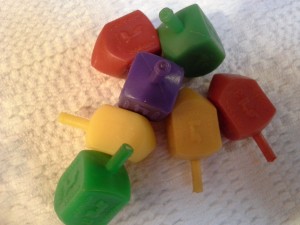Have you ever played the Dreidel game?
Or used the Dreidel song in your early childhood music groups? It is a well-known and popular children’s song and game sung during the Jewish holiday of Chanukah.
I have a little Dreidel
I made it out of clay
And when it’s dry and ready
My Dreidel I will play
The tune varies with the singer (like many well-traveled melodies) but follows the contour of the notes of the triad. In this first section, I boost the emphasis on the meter by stamping hard on the first beat of each measure. After the simple introduction, a toy similar to a top is spun round and round until it loses momentum and falls down. The intervals of the spinning section are repeated descending minor thirds. We sing quicker and quicker to match the twirling. When I play it with my little ones, I love to exaggerate this contrast of tempo. The speed of the singing and clapping gets faster and faster, just like the spinning Dreidel. A sudden stop after a frenetic second section when the Dreidel falls, adds to the surprise and drama and fun.
The disparity in this song between the heavy stamping followed by spinning almost out of control and then the fall to the ground, always reminds me of the struggles that many of our young children face when coping with sensory difficulties. I was reminded again of this challenge for young kids by a new research article on the relationship between Autism and synesthesia – a condition where one sensory modality, such as hearing, also triggers another modality such as smell. (http://www.molecularautism.com/content/4/1/40/abstract) How confusing must the world be, when being constantly bombarded by sounds and sights and sensations?
One of the reasons I play the Dreidel game in my groups is to use the very clear structure of the music to help children experience all these different sensory states and then be able to predict the changes and organize their responses. The playful nature of the game masks the work that happens as the children practice how to cope. They learn and internalize both the song and the movements. Gradually they can learn and internalize how to handle and manage the barrage of experiences that life brings.
Open this link from the Sprouting Melodies website to hear how I do the song along with more thoughts about the music:
http://vimeo.com/80801978
You can find more resources about music, music therapy and sensory difficulties in:
Berger, D. S., (2002). Music therapy, sensory integration and the autistic child. London: Jessica Kingsley.
Kern, P. & Humpal, M. (Eds.) (2012). Early childhood music therapy and autism spectrum disorders: Developing potential in young children and their families. Philadelphia and London: Jessica Kingsley Publishers.



